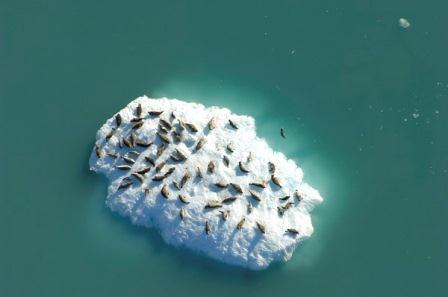Post-Breeding Season Migrations

NPS
Harbor seal populations in Glacier Bay may be one of the most protected, as Glacier Bay is one of the largest marine protected areas in the northern hemisphere. A study conducted by the National Park Service in collaboration with the National Marine Mammal Laboratory and Oregon State University quantified the post-breeding season (September-April) movement patterns of harbor seals in relation to marine protected area boundaries of Glacier Bay.
Satellite-linked transmitters were attached to 37 juvenile and adult female harbor seals in September of 2007 and 2008 in Johns Hopkins Inlet. Harbor seal tracks were analyzed using state-space models and utilization distributions were created in ArcGIS to quantify space use of seals relative to the marine protected areas of Glacier Bay.
Harbor seals traveled extensively throughout southeastern Alaska, the eastern Gulf of Alaska, and Prince William Sound, utilizing an area of approximately 25, 325 km2. These movements included the longest migration yet recorded for a harbor seal (3, 411 km) and extended use (up to 23 days) of pelagic areas by some seals. Although the collective distribution of harbor seals during the post-breeding season was expansive, there was a substantial degree of individual variability in the percentage of days that seals spent in the marine protected area. Nevertheless, the majority of the harbor seals (93%) returned to Glacier Bay the following breeding season (May-June). Results demonstrate the importance of better understanding the threats that a highly moblie species may interact with outside the marine protected area of Glacier Bay.
Diving Behavior and Prey Availability

NPS / JAMIE WOMBLE
Few empirical studies have investigated the linkages between prey availability and pinniped foraging and diving behavior. Researchers in Glacier Bay National Park and Preserve in collaboration with the Alaska Department of Fish & Game, Alaska Fisheries Science Center, and Oregon State University conducted a study that assessed harbor seal diving behaivor and local prey fields in glacial ice and terrestrial habitats in Glacier Bay.
Twelve juvenile female harbor seals were instrumented with time-depth recorders and VHF (Very High Frequency) tags during spring (2004-2007): 6 from terrestrial sites in lower Glacier Bay and 6 from a glacial ice habitat in Johns Hopkins Inlet. Vessel-based VHF tracking was conducted to identify seal foraging areas and hydroacoustic surveys were conducted in order to provide an index of prey depth and density in glacial ice and terrestrial habitats in Glacier Bay.
There was distinct separation in the diving behavior of seals from terrestrial and glacial ice habitats. Seals in glacial ice habitats tended to travel further to foraging sites, had longer transit times, and deeper dive depths than seals that hauled out near terrestrial sites. Prey availability near the terrestrial site was higher in density and shallower in the water column compared to the deep fjord of Johns Hopkins Inlet. So why haul out on ice? The increased diving effort for seals from glacial ice sites suggests that the lower relative availability of prey may be offset by other factors, such as the stability of glacial ice as a resting platform and as a refuge from predation.
References
1. Womble, J.N., et al. (2014) Linking marine predator diving behavior to local prey fields in contrasting habitats in a subarctic glacial fjord. Marine Biology, 161, 1361-1374.
2. Womble, J.N., Gende, S.M. (2013) Post-breeding season migrations of a top predator, the harbor seal, from a marine protected rea in Alaska. PLOS ONE, 8(2), 1-15.
3. Womble, J.N., et al. (2010) Harbor seal declines continue in the rapidly changing landscape of Glacier Bay National Park, AK, 1992-2008. Marine Mammal Science, 26, 686-697.
4. Mathews, E.A., and Pendleton, G.W. (2006) Declines in harbor seal numbers in Glacier Bay National Park, AK 1992-2002. Marine Mammal Science, 22, 170-191.
Research conducted under NOAA MMPA permits #358-1787-00, 358-1787-02, 782-1676-02.
Last updated: November 22, 2021
